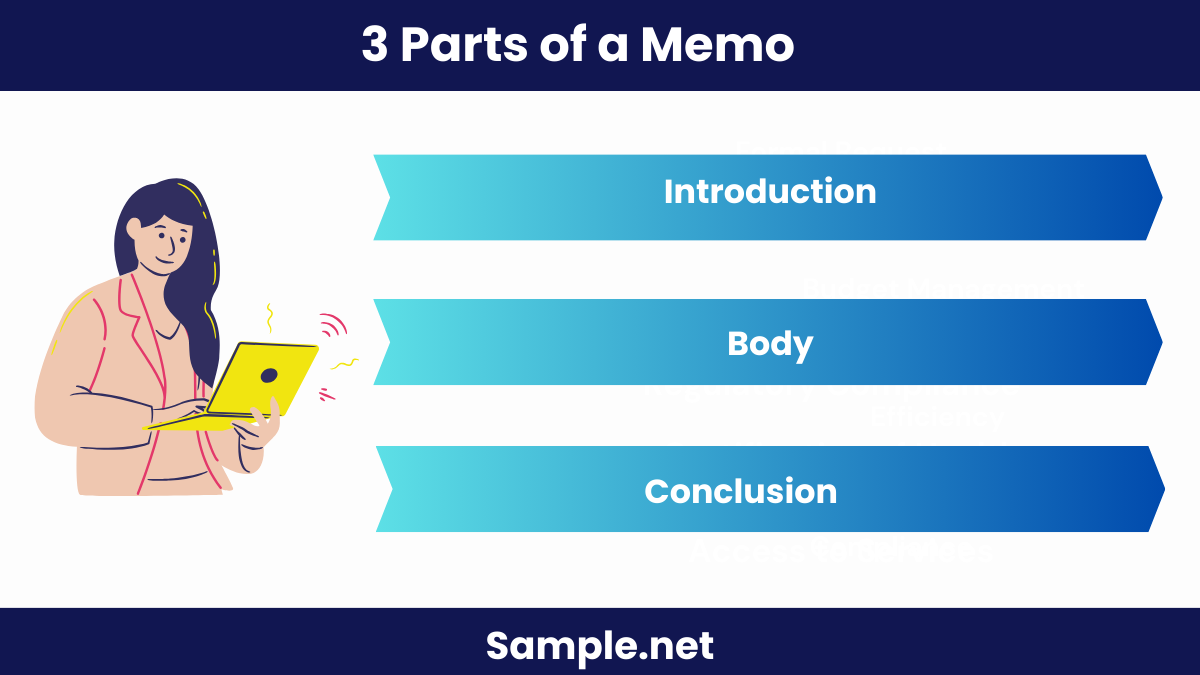School Memo Samples
-
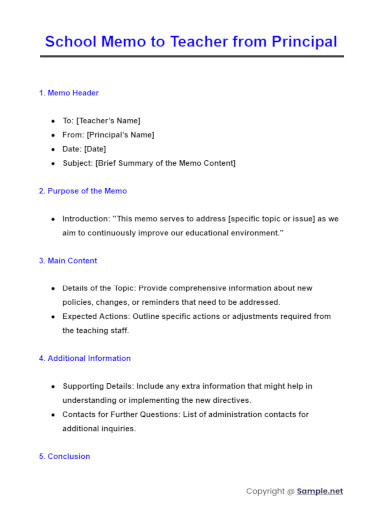
School Memo to Teacher from Principal
download now -
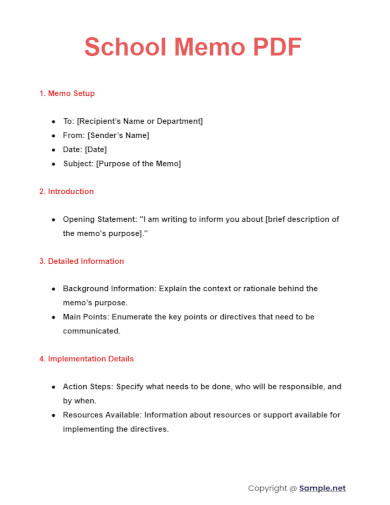
School Memo PDF
download now -
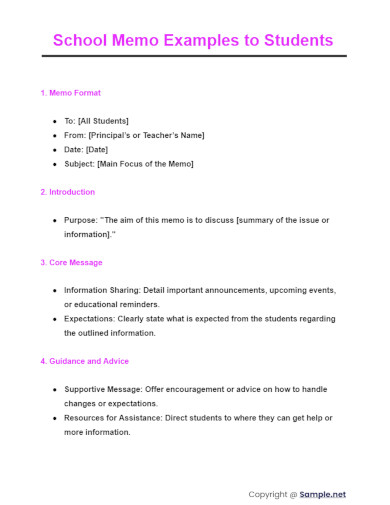
School Memo Examples to Students
download now -
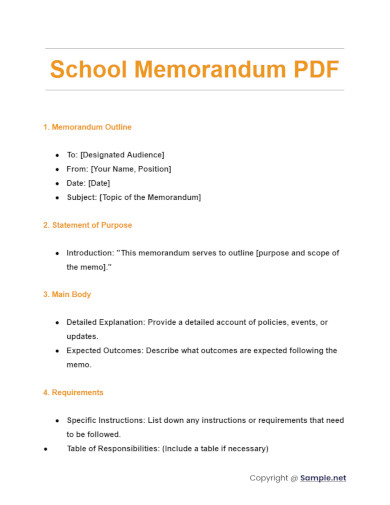
School Memorandum PDF
download now -

Formal School Memo Template
download now -
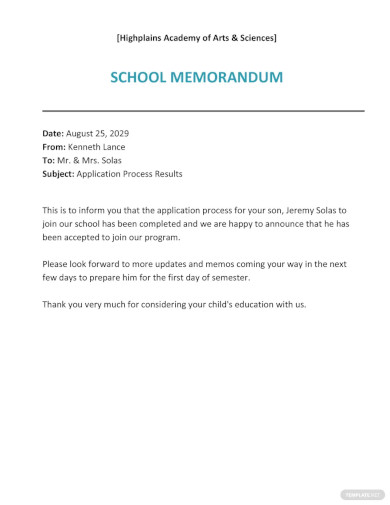
School Memo to Parents Template
download now -
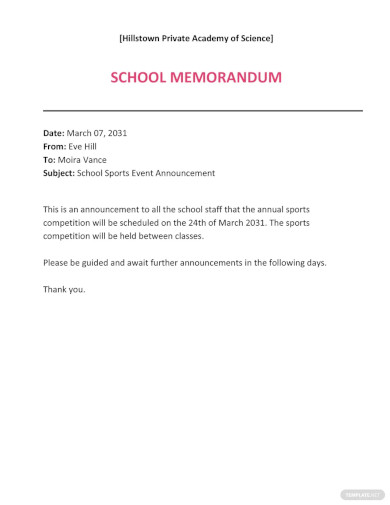
Private School Memo Template
download now -
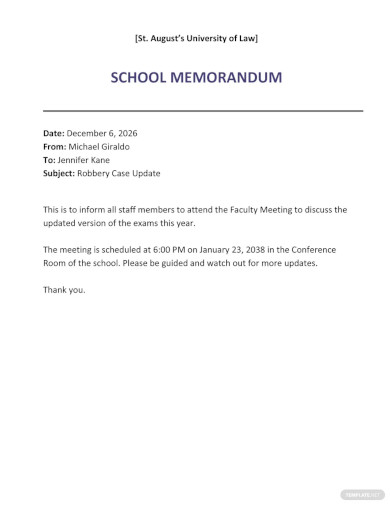
Free Law School Memo Format Template
download now -
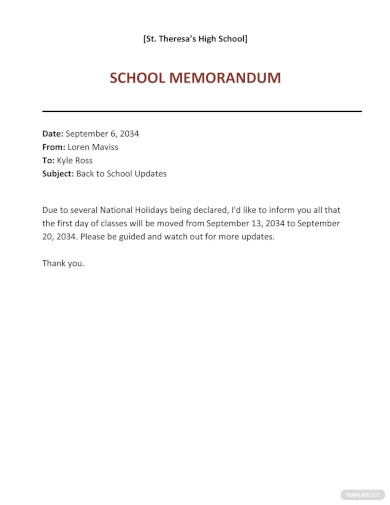
Free Back to School Memo Template
download now -

Free Sample School Memo Template
download now -
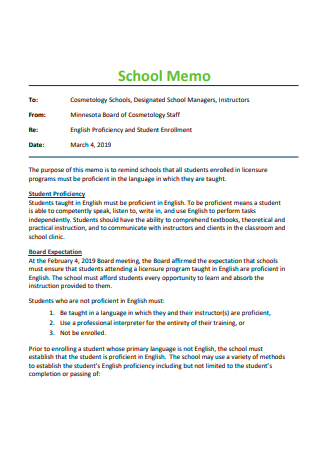
School Memo Template
download now -

High School Teacher Memo
download now -

Public School Operations Memo
download now -
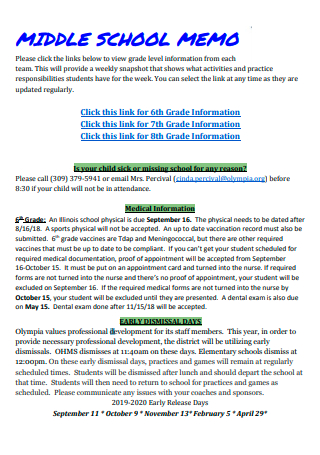
Middle School Meeting Memo
download now -

School District Board of Education Memo
download now -
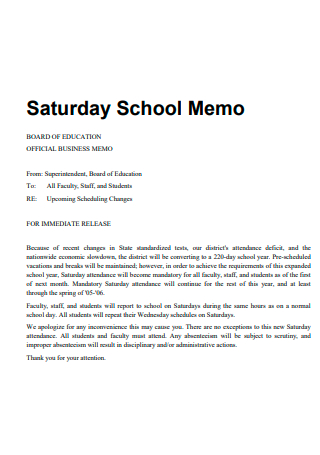
Saturday Uniform School Memo
download now -
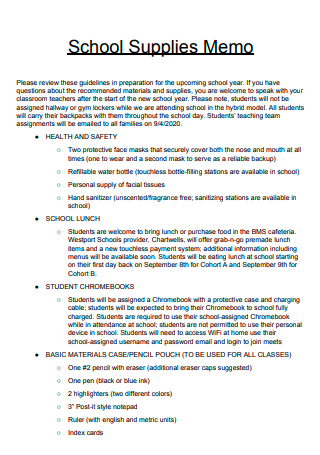
Business School Supplies Memo
download now -
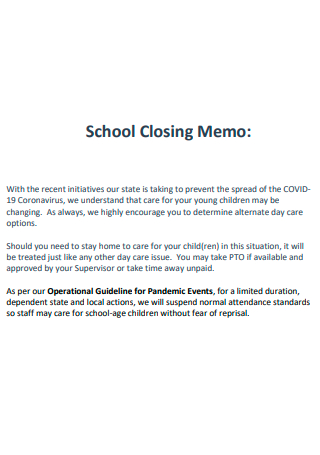
School Closing Memo Letter
download now -
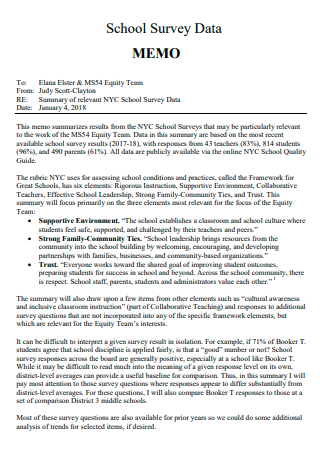
School Holiday Survey Data Memo
download now -
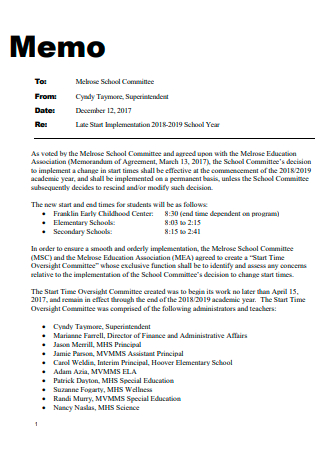
School Reading Committee Memo
download now -
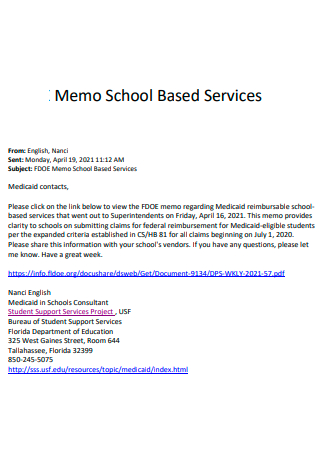
School Absenteeism Services Memo
download now -
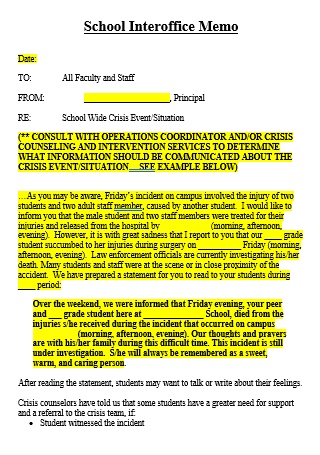
School Inter-Office Project Memo
download now -
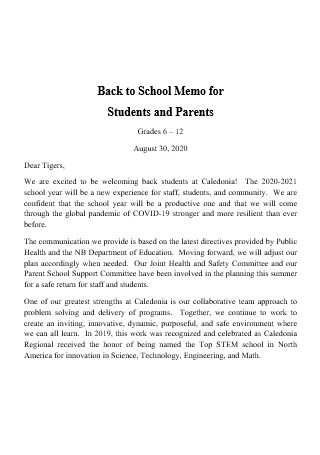
School Memo For Students and Parents
download now
FREE School Memo s to Download
School Memo Format
School Memo Samples
What is a School Memo?
Purpose of Issuing a Memo
Advantages of a Memo
How to Write a School Memo
Why do teachers use memorandum?
Are memos external documents?
When to use a memo?
What are the 3 Parts of a Memo?
How Do You Write a Student Memo?
What are the 5 Types of Memo?
What are the 4 Words Used in the Memo?
What are the 7 Steps to Write a Memo?
How to Make a Memo?
What Should I Put in a Memo?
What Does Writing a Memo Look Like?
How Do I End a Memo?
What is the First Sentence of a Memo?
How Long Should a Memo Be?
What Information Goes in a Memo?
What Does an Instruction Memo Do?
What Does “Re” Mean in a Memo?
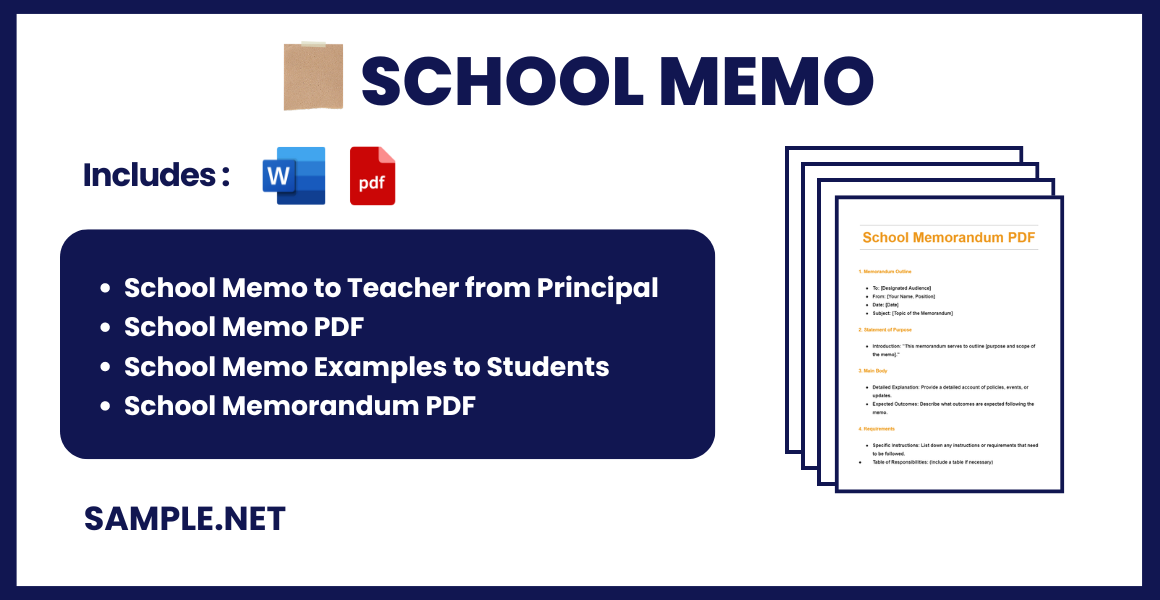
School Memo Format
To: [Recipient’s Name/Title/Department] From: [Your Name/Title] Date: [DD/MM/YYYY] Subject: [Purpose of the Memo]
Introduction:
- Purpose of the Memo: [Briefly state the purpose]
Main Content:
- Details: [Provide detailed information, instructions, or updates]
Action Required:
- Tasks and Deadlines: [Specify required actions and deadlines]
Closing:
- Additional Information: [Offer to provide additional information or assistance]
- Contact Information: [Your contact details]
What is a School Memo?
A school memo is a concise document used to communicate important information within a school environment. It serves as an official means to convey messages between staff members, departments, or from administration to students and parents. Typically, a school memo includes a clear headline, a brief introduction, the body containing the main message, and a conclusion or call to action. The purpose is to ensure that relevant parties receive essential information efficiently, ranging from administrative announcements to reminders about policies or upcoming events. The format and tone may vary depending on the audience and urgency of the messag
Purpose of Issuing a Memo
Various reasons will be the cause to resort to delivering news through a memo since not all the time would information warrant a need to be exchanged through email, reference Letters, or other forms of communication essential to the learning environment. There could be a day that you would need to send out a school holiday memo or a gathering that requires the school to all be in attendance. The possibilities are endless and if you are unsure if the particular reason requires a memo, then this list will help you be more aware of such a situation.
Advantages of a Memo
Reading the list above already gives you a comprehensive view of the uses and purposes that a school memo fulfills. If you are still unsure regarding the benefits that you or your school administrators gain from utilizing a school memo, then this next curated list is for you. Give it a thorough read before proceeding to the guide below. It is important for you to know that these advantages will help you in the long run and avoid issues that could be detrimental to the function and operation of your school.
How to Write a School Memo
Information requests, confirmation, monthly updates, suggestions, and study results memos are all examples of memos. Memos are expected to have a neutral tone, whereas a report memo should include pertinent facts and figures. While all memos have a similar format, there may be some changes in the message’s content. If you need to include a set of data, you can express the main message as plain text or include rows, columns, or tables. A memo, unlike a traditional business letter, lacks a salutation and the sender’s signature. Take time to view a provided sample of a school memorandum to be informed of the expected school memo format. You should also take a look at our Legal Memo
-
1. Add a Heading
The school’s official or full name and address, which are usually already printed on a letterhead, are included in the heading section. The term “Memo” or “Memorandum” comes just below the address section or letterhead, indicating that the message is being communicated through a memo. Other inclusions you can add are the school’s official logo, contact information, and often even the link for the Website address so that readers can easily access it. You should also take a look at our Audit Memo
-
2. Mention the Date and Recipient
Every memo must indicate the date that it was written. In addition, the recipients are identified in this section. For example, if you are writing a note to all college department students, you should appropriately include or mention them as your addressee. If it is an institutional school memo, then there is no need to specify the readers in the recipient section. You should also take a look at our Project Memo
-
3. Include a Subject Line
The subject line provides the recipients with a sample brief overview of the memo’s content. It should be succinct and straight to the point since the memo’s title is determined by the subject line. Your audience will influence the style and tone you employ in a memo: you can use a more informal tone in a memo to a coworker you know well, but you should use a more professional tone in a note to your boss. It’s critical to keep your memos nicely organized and adding a subject line can help that. You should also take a look at our Business Memo
-
4. Forward to Additional Recipients
These are the individuals toward whom you send a copy of the memo for informational purposes but who are not directly addressed in the recipient section. You could be sending a school memo to the students of a particular department but also may want to send a copy to their respective parents or professors in their certain department. CC refers to carbon copy whereas BCC stands for blind carbon copy in an email function. The distinction between carbon copy (CC) and blind carbon copy (BCC) receivers is that CC recipients are visible to all other recipients, whereas BCC recipients are not visible to anybody. You should also take a look at our School Development Plan
-
5. Compose Message Body
In one to three short paragraphs, this part must convey the message you are intending to send out. The aim or purpose of writing the memo should be stated first, followed by the rest of the message that contains the other information or data required to provide backing or reason for the contents of the news, the updates, or even changes in specific areas of the institution. If the content of this section is lengthy, you might want to provide a message Summary report at the end of the school memo. The letter should end with a clear call to action, indicating what the receivers should do next. You should also take a look at our School Improvement Plan
-
6. Attachments
Not all memorandum or school memos would require a need for you to attach other documents within the email. Though some memos, such as those relating to research and results presentation, may require supplementary data in the form of an attachment to back up the memo’s message. Even a mandated attendance for a particular Class schedule may be stated and provided a foundation through the issuance of government law. Attachments will help the recipient to be more aware of the intentions of the school memo. You should also take a look at our School Funding Proposal
Why do teachers use memorandum?
The messages are extremely vital. Their material addresses issues that should worry pupils, and professors can provide helpful counsel. The memos in this article are yours to use as-is presented through a template or modified to better correspond with the guidance you believe your students require. In the same way that a principal’s school note to teachers sends an intended message without having to individually contact each member of the school staff. Even if the Meeting minutes was scheduled a few days in advance, a memorandum is proven to be an effective way to send out an announcement or notice. You should also take a look at our School Budget Plan
Are memos external documents?
Memos, regardless of the classification, are usually utilized as internal documents delivered to employees to provide organizational information, whereas business letters are external communications, frequently connected to sales efforts or client needs, or to inquire about a vendor or government agency. When the information to be shared is informal and not secret, a school memorandum, memoranda, or memo is a frequent type of institutional communication. It is not a good idea to disclose confidential information in a memorandum; instead, write a letter or use another method of communication. You should also take a look at our School Incident Report
When to use a memo?
When writing a long-lasting message, use a memo. Make your communication a memo if it’s a lengthy proposal, a substantial report, a serious recommendation, a technical explanation, meeting minutes, a new policy, or anything else that readers will refer to multiple times. Your viewers will be able to store the document, read it, and find it again if they need it. Choose a note to communicate formally. Memos include a space at the top of the message for the sender’s and receiver’s professional titles, as well as the company name and logo. These additions give the message a more formal appearance. A well-formatted message also displays importance. You should also take a look at our School Notes
What are the 3 Parts of a Memo?
A standard memo is divided into three essential parts to ensure clarity and effectiveness.
- Introduction: Briefly states the memo’s purpose and urgency.
- Body: Detailed section that outlines the information or request, much like outlining a School Action Plan.
- Conclusion: Summarizes the memo content and details any actions required by the reader. You should also take a look at our School Notice
How Do You Write a Student Memo?
Writing a student memo involves clarity and directness to ensure the message is understood and acted upon efficiently.
- Address the Audience: Clearly state who the memo is for, typically addressing the student body or specific groups.
- Specify the Purpose: Immediately clarify the purpose of the memo.
- Provide Details: Include necessary details students need to know, similar to those found in a School Fee Receipt.
- Call to Action: Clearly state what actions students need to take or the behavior expected from them.
- Close Formally: End with a professional closing that reiterates any action required and offers a contact for further questions. You should also take a look at our School Daily Schedule
What are the 5 Types of Memo?
Memos can vary widely depending on their intended purpose within the educational setting.
- Informational Memo: To inform staff or students about general school updates.
- Directive Memo: Issues instructions based on new policies or procedures.
- Response Memo: Answers to requests or inquiries, like feedback on a School Project Proposal.
- Confirmation Memo: Confirms agreements or discussions, ensuring all parties have the same information.
- Periodic Report Memo: Regular updates on ongoing activities, similar to a School Visit Report.
What are the 4 Words Used in the Memo?
Certain keywords help to clarify the intent and urgency of a memo.
- Immediate: Indicates high priority or urgency.
- Mandatory: Suggests that the instructions must be followed.
- Request: Used when asking for something to be done.
- Confirm: Often used when seeking verification or agreement. You should also take a look at our School Feasibility Report
What are the 7 Steps to Write a Memo?
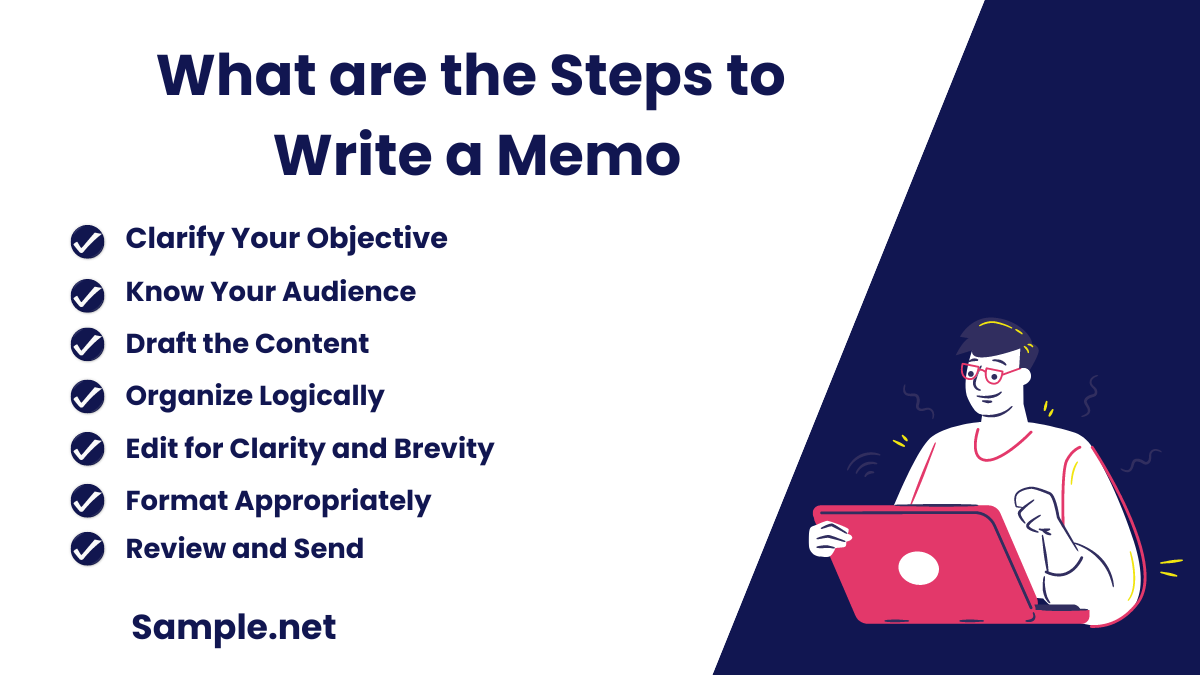
Writing an effective memo involves a series of steps to ensure the message is clear and actionable.
- Clarify Your Objective: Understand and define the memo’s purpose.
- Know Your Audience: Tailor the message to the recipients’ understanding, similar to a School Business Plan.
- Draft the Content: Write a clear, concise, and direct memo.
- Organize Logically: Arrange information in a logical order to enhance comprehension.
- Edit for Clarity and Brevity: Ensure the memo is easy to read and to the point.
- Format Appropriately: Use a professional and readable layout.
- Review and Send: Check the memo for errors and distribute it to the intended audience. You should also take a look at our School Charity Proposal
How to Make a Memo?
Creating a memo requires attention to detail and a clear understanding of the desired outcome.
- Header: Start with a header that includes the memo’s date, to/from, and subject.
- Opening: Clearly state the memo’s purpose.
- Explain in Detail: Expand on the information, referencing any relevant issues like a School Survey Report.
- Specify Actions: Clearly state any required actions or deadlines.
- Closing: Offer to provide further information and thank the readers for their attention. You should also take a look at our School Business Report
What Should I Put in a Memo?
A memo should contain specific elements to ensure it communicates effectively and prompts the appropriate response.
- Purpose Statement: Clearly state why the memo has been written.
- Summary: If the memo is long, provide a brief summary at the beginning. You should also take a look at our School Emergency Action Plan
- Background: Give context necessary for understanding the situation or decision.
- Details: Provide all relevant details needed to understand the actions to be taken.
- Actionable Items: Specify what actions are required, aligning with the strategic direction like that seen in School Receipt.
What Does Writing a Memo Look Like?
Writing a memo involves a clear, structured format with a header, introduction, body, and conclusion, similar to an Credit Memo.
How Do I End a Memo?
End a memo with a clear call to action or summary, offer further contact if needed, and sign-off politely, akin to a Meeting Memo.
What is the First Sentence of a Memo?
The first sentence of a memo should state the primary purpose or action required, setting the tone similar to an Investment Memo.
How Long Should a Memo Be?
A memo should be concise; ideally, no more than a single page to ensure the information is quickly and easily digestible like an Interoffice Memo.
What Information Goes in a Memo?
A memo should include the purpose, necessary background information, main message, and required actions, much like a Memorandum of Understanding.
What Does an Instruction Memo Do?
An instruction memo provides detailed guidelines or steps to follow for specific procedures, similar to directives in a Business Memorandum.
What Does “Re” Mean in a Memo?
In a memo, “Re” stands for “regarding” or “in reference to,” indicating the subject or purpose of the document, typical in an Internal Memo.
Concluding this exploration of school memos, it’s evident that these documents are pivotal for streamlined communication within educational settings. The ability to draft precise, authoritative, and action-oriented memos can significantly enhance operational efficiency and information dissemination. This article has provided insights into various types of memos, including general school-wide announcements and specific IT Memo scenarios, ensuring readers are well-equipped to handle diverse communicative needs. By utilizing the samples, forms, and guidelines provided, school administrators and staff can effectively maintain a well-informed and cohesive educational environment.

